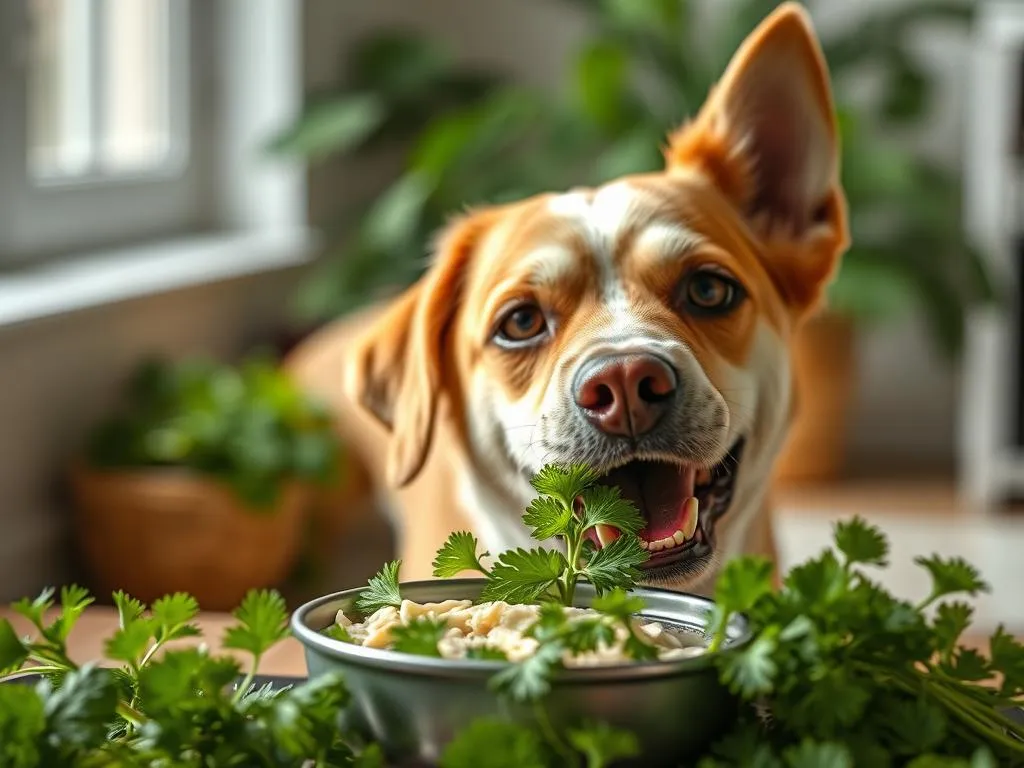
Introduction
Understanding dog nutrition is crucial for ensuring our furry friends lead healthy and happy lives. A balanced diet plays a significant role in a dog’s overall health, affecting everything from their coat quality to their energy levels. One intriguing addition to a dog’s diet is parsley. This common herb, often used in culinary dishes, raises the question: can dogs eat parsley? In this article, we’ll delve into the safety and potential benefits of parsley for dogs, explore its nutritional value, and discuss any risks associated with its consumption.
Understanding Dog Nutrition
The Basics of Dog Nutrition
A well-rounded diet for dogs consists of macronutrients and micronutrients.
- Macronutrients include proteins, fats, and carbohydrates, which provide the energy necessary for daily activities.
- Proteins are vital for muscle and tissue development.
- Fats are essential for energy, supporting cell function and absorption of certain vitamins.
-
Carbohydrates provide quick energy and help maintain a healthy digestive system.
-
Micronutrients encompass vitamins and minerals that support various bodily functions.
- Vitamins like A, D, E, and K play roles in vision, bone health, and immune function.
- Minerals such as calcium and phosphorus are crucial for bone health and metabolic processes.
A balanced diet is essential not just for physical health but also for mental well-being.
Common Nutritional Needs of Dogs
Dogs, like humans, have unique nutritional needs based on several factors:
- Age: Puppies require more protein and calories for growth, while senior dogs need fewer calories and more fiber.
- Breed: Larger breeds often need different nutrient ratios compared to small breeds, particularly in terms of joint health.
- Size: The size of the dog can dictate their caloric intake and specific dietary requirements.
Understanding these factors ensures that each dog receives the right balance of nutrients for their specific life stage and lifestyle.
Parsley: An Overview
What is Parsley?
Parsley is a popular herb that comes in two main varieties: flat-leaf (Italian) and curly. Both types are commonly used in cooking, often as a garnish or flavor enhancer. Parsley is widely available in grocery stores, making it an accessible herb for pet owners curious about adding a bit of greenery to their dog’s diet.
Nutritional Profile of Parsley
Parsley boasts a rich nutritional profile, providing several essential vitamins and minerals:
- Vitamin K: Important for blood clotting and bone health.
- Vitamin C: A potent antioxidant that supports the immune system.
- Iron: Crucial for red blood cell production.
- Folate: Beneficial for cell division and tissue growth.
The health benefits of parsley extend beyond its nutritional content, making it a noteworthy herb for canine diets.
Can Dogs Eat Parsley?
Safety of Feeding Parsley to Dogs
When considering if dogs can eat parsley, it’s essential to understand the safety of both flat-leaf and curly varieties. Generally, both types are safe for dogs in moderation. However, toxic varieties of parsley, such as wild parsley, can be harmful. Therefore, it’s crucial to ensure that only the common culinary types are fed to dogs.
Health Benefits of Parsley for Dogs
Feeding parsley to dogs can offer several health benefits:
- Freshening Breath: Parsley can help combat bad breath due to its antibacterial properties.
- Aiding Digestion: The fiber content can support digestive health and alleviate gas.
- Antioxidant Properties: The vitamins and compounds found in parsley can help reduce oxidative stress.
- Anti-Inflammatory Effects: Parsley may help reduce inflammation, benefiting dogs with arthritis or joint issues.
These benefits make parsley an appealing addition to a canine diet.
Risks and Considerations
While parsley has several benefits, there are potential risks to consider:
- Allergic Reactions: Some dogs may be allergic to parsley, showing symptoms such as itching or gastrointestinal upset.
- Portion Size: Feeding too much parsley can lead to gastrointestinal issues like vomiting or diarrhea. It’s best to start with small amounts and monitor your dog’s reaction.
- Caution Against Large Quantities: Excessive consumption of parsley can lead to more serious health issues due to certain compounds in the herb.
Being aware of these risks ensures that parsley can be safely enjoyed as part of a balanced diet.
How to Incorporate Parsley into a Dog’s Diet
Fresh vs. Dried Parsley
When incorporating parsley into your dog’s diet, you can choose between fresh and dried parsley.
- Fresh Parsley: Offers a more potent flavor and retains more nutrients. It can be easily chopped and added to dog food or treats.
- Dried Parsley: While still beneficial, it may lose some nutritional value. It can be sprinkled over meals but should be used in smaller quantities due to its concentrated flavor.
Both forms can be beneficial, but fresh parsley is generally recommended for its enhanced health benefits.
Homemade Dog Treats with Parsley
Creating homemade dog treats that include parsley is a fun and healthy way to incorporate this herb into your dog’s diet. Here are a couple of simple recipes:
Parsley and Peanut Butter Dog Biscuits
- Ingredients:
- 1 cup whole wheat flour
- 1/4 cup fresh parsley, chopped
- 1/2 cup peanut butter (ensure it’s xylitol-free)
-
1/4 cup water
-
Instructions:
- Preheat your oven to 350°F (175°C).
- Mix all ingredients until a dough forms.
- Roll out the dough and cut into shapes.
- Bake for 20-25 minutes or until golden brown.
- Let cool before serving.
Parsley and Sweet Potato Chews
- Ingredients:
- 1 cup mashed sweet potato
- 1/4 cup fresh parsley, chopped
-
1 cup oats
-
Instructions:
- Preheat your oven to 350°F (175°C).
- Combine all ingredients in a bowl.
- Shape into small balls and place on a baking sheet.
- Bake for about 30 minutes until firm.
- Cool before offering to your dog.
These treats are not only delicious but also provide a healthy boost of nutrients!
Commercial Dog Foods Containing Parsley
If making treats isn’t feasible, many commercial dog food brands incorporate parsley into their recipes for its nutritional value. Brands that focus on natural ingredients often include parsley as part of their formula. Always look for high-quality dog foods that list parsley among the first few ingredients, as this indicates a better nutritional profile.
Alternatives to Parsley
Other Herbs Safe for Dogs
If you’re considering alternatives to parsley, several other herbs are safe and beneficial for dogs:
- Basil: Known for its anti-inflammatory properties.
- Rosemary: Contains antioxidants and can promote healthy digestion.
- Mint: Freshens breath and aids digestion.
These herbs can provide similar benefits and can be easily incorporated into your dog’s meals.
Supplementation Options
In some cases, dogs may need additional supplementation to support their health. Common supplements include:
- Fish Oil: For omega-3 fatty acids, promoting skin and coat health.
- Probiotics: To support gut health and digestion.
- Multivitamins: To fill any nutritional gaps in their diet.
Consulting with a veterinarian will help determine if supplementation is necessary for your dog.
Conclusion
In summary, dogs can eat parsley safely in moderation and can benefit from its nutritional properties. However, as with any dietary changes, it’s essential to consult with a veterinarian before introducing new foods. A balanced diet is crucial for your dog’s health, and monitoring their reactions to new ingredients is vital. Prioritizing nutritious foods will help ensure your dog remains healthy and vibrant throughout their life.
FAQs
Common Questions About Dogs and Parsley
-
Can dogs eat parsley every day?
While parsley is safe in moderation, it shouldn’t be a daily staple. Offering it occasionally as a treat is best. -
What should I do if my dog eats too much parsley?
If your dog consumes a large amount of parsley, monitor them for signs of gastrointestinal upset. If symptoms persist, consult your veterinarian. -
Are there any other herbs that dogs should avoid?
Yes, some herbs like garlic and onion are toxic to dogs and should be avoided.
General Questions About Dog Nutrition
-
What are the signs of a balanced diet in dogs?
Signs include a shiny coat, healthy skin, consistent energy levels, and normal weight. -
How can I tell if my dog is allergic to a certain food?
Allergic reactions can manifest as itching, gastrointestinal upset, or changes in behavior. Consulting a veterinarian is recommended for proper diagnosis and management.









